
|
Now it is 3.6 mag (Nov. 22, Osamu Miyazaki). Although it had been fainter than predicted, an outburst occured on Nov. 13 and the comet is brightening rapidly now. It will approach to the sun down to only 0.01 A.U. on Nov. 28, and is expected to be a great comet. In this week, we can see the comet passes very near by the Sun via the SOHO images. The condition is excellent in the Northern Hemisphere. It keeps observable almost all through the period of brightening, at the highlight, and of fading. The condition is not good in the Southern Hemisphere. It is not observable at all the latter part of the highlight, and it keeps low all through the period.
Date(TT) R.A. (2000) Decl. Delta r Elong. m1 Best Time(A, h)
Nov. 23 14 30.70 -17 38.0 0.861 0.342 19 4.2 5:13 (292, 0)
Nov. 30 16 21.38 -16 20.5 0.912 0.114 5 0.7 5:19 (280,-15)
|

|
Now it is so bright as 5.0 mag (Nov. 22, Osamu Miyazaki). It will pass only 0.4 A.U. from the earth, and 0.8 A.U. from the sun in November and December, and will brighten up to 4-5 mag. In the Northern Hemisphere, it keeps observable in excellent condition for a long time until 2014 autumn when the comet will fade out. In the Southern Hemisphere, it is not be observable from mid November to early February.
Date(TT) R.A. (2000) Decl. Delta r Elong. m1 Best Time(A, h)
Nov. 23 12 34.05 42 16.1 0.406 0.984 77 4.6 5:13 (244, 53)
Nov. 30 14 36.53 41 18.5 0.478 0.918 67 4.5 5:19 (241, 36)
|
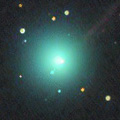
|
It brightened rapidly as expected. It passed the perihelion on Nov. 21, and brightened up to 7.8 mag (Nov. 18, Todd Augustyniak). It will never be observable after this.
Date(TT) R.A. (2000) Decl. Delta r Elong. m1 Best Time(A, h)
Nov. 23 14 46.83 -17 3.2 1.143 0.338 16 7.3 5:13 (289, -3)
Nov. 30 15 37.51 -22 28.2 1.327 0.403 10 8.2 5:19 (291, -9)
|
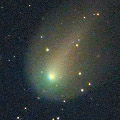
|
Although it was predicted to be 14 mag, it is extremely bright as 8.2 mag in outburst now (Nov. 12, Marek Biely). The round dust shell is expanding and getting diffuse. It will be observable in excellent condition in 2014 spring. In the Northern Hemisphere, it will be getting higher gradually in the morning sky. In the Southern Hemisphere, it is not observable until 2014 February.
Date(TT) R.A. (2000) Decl. Delta r Elong. m1 Best Time(A, h)
Nov. 23 14 32.58 18 54.6 2.589 2.000 43 8.7 5:13 (261, 20)
Nov. 30 14 52.72 17 33.0 2.514 1.947 45 8.8 5:19 (264, 22)
|

|
New bright comet. It brightened very rapidly after discovered on Nov. 6 at 15 mag. Now it is so bright as 8.8 mag (Nov. 15, Marco Goiato). It seems to keep 8-9 mag for a while after this. It is observable in excellent condition in the Northern Hemisphere. It locates somewhat low in the Southern Hemisphere.
Date(TT) R.A. (2000) Decl. Delta r Elong. m1 Best Time(A, h)
Nov. 23 9 42.94 12 58.1 0.938 1.442 97 9.0 5:13 (346, 67)
Nov. 30 10 0.73 16 13.3 0.919 1.472 101 9.0 5:19 (355, 71)
|
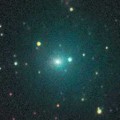
|
It brightened very rapidly. Now it is so bright as 10.9 mag (Nov. 22, D. Sidorko). It keeps bright as 10 mag from autumn to winter. In the Northern Hemipshere, it keeps observable in excellent condition until the comet fades out. In the Southern Hemisphere, it keeps observable in good condition within 2013, but it will not be observable in 2014.
Date(TT) R.A. (2000) Decl. Delta r Elong. m1 Best Time(A, h)
Nov. 23 22 28.75 7 7.6 1.119 1.622 100 10.8 18:19 ( 0, 62)
Nov. 30 22 39.97 9 10.1 1.162 1.614 97 10.7 18:18 ( 8, 64)
|
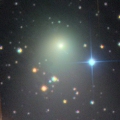
|
It became much brighter than expected, and reached up to 8.5 mag (Aug. 15, Alexandre Amorim). Now it is fading, but it is bright as 10.7 mag still now (Nov. 5, Alexandre Amorim). In the Southern Hemisphere, it will keep observable in good condition for a long time until 2014 summer when the comet fades out. It will never be observable again in the Northern Hemisphere.
Date(TT) R.A. (2000) Decl. Delta r Elong. m1 Best Time(A, h)
Nov. 23 12 50.26 -57 52.3 2.474 1.991 50 11.5 5:13 (334,-13)
Nov. 30 13 16.54 -59 49.8 2.538 2.055 50 11.9 5:19 (337,-14)
|

|
Now it is 14.0 mag and visible visually (Sept. 6, Sandor Szabo). It is expected to brighten up to 5-6 mag in 2014 autumn. In the Northern Hemisphere, it keeps observable in good condition for a long time, although it will be unobservable temporarily in late November. In the Southern Hemisphere, it will not be observable until 2014 February.
Date(TT) R.A. (2000) Decl. Delta r Elong. m1 Best Time(A, h)
Nov. 23 15 58.56 10 22.4 4.716 3.899 30 13.3 18:19 (103, 0)
Nov. 30 16 2.40 10 12.1 4.623 3.825 32 13.2 5:19 (260, 4)
|
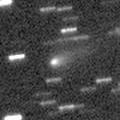
|
First return of a new periodic comet discovered in 1998. It brightened up to 10 mag at the discovery. Now it is 14.7 mag (Nov. 8, Sandor Szabo). In the Northern Hemisphere, it keeps observable in excellent condition from autumn to spring. A bit fainter than originally expected, but it will brighten up to 12 mag. It locates somewhat low in the Southern Hemisphere.
Date(TT) R.A. (2000) Decl. Delta r Elong. m1 Best Time(A, h)
Nov. 23 6 54.36 41 35.0 1.569 2.385 136 13.4 2:47 (180, 83)
Nov. 30 6 53.41 41 21.3 1.495 2.358 142 13.2 2:19 (180, 84)
|

|
It approached to the sun down to 0.73 A.U. on Mar. 24, and brightened up to 4.7 mag (Mar. 11, Michael Mattiazzo). Now it is fading. But it is still bright as 11.9 mag (Oct. 30, Jakub Cerny). In the Northern Hemisphere, it keeps observable in good condition while fading gradually. In the Southern Hemisphere, it will never be observable again.
Date(TT) R.A. (2000) Decl. Delta r Elong. m1 Best Time(A, h)
Nov. 23 19 10.53 49 34.6 3.693 3.693 82 13.4 18:19 (128, 51)
Nov. 30 19 17.73 49 6.2 3.805 3.771 80 13.6 18:18 (127, 48)
|

|
Now it is 11.8 mag (Nov. 8, Sandor Szabo). It keeps 11-13 mag until autumn, but it keeps locating extremely low in the morning sky.
Date(TT) R.A. (2000) Decl. Delta r Elong. m1 Best Time(A, h)
Nov. 23 12 30.92 -20 2.1 2.352 1.835 47 13.5 5:13 (313, 19)
Nov. 30 12 40.96 -23 3.3 2.363 1.908 51 13.7 5:19 (319, 20)
|

|
Now it is 13.3 mag and visible visually (Nov. 8, Sandor Szabo). It keeps 13-14 mag and observable in good condition in the Northern Hemisphere for a long time from 2013 to 2014. In the Southern Hemisphere, it is not observable until 2014 autumn.
Date(TT) R.A. (2000) Decl. Delta r Elong. m1 Best Time(A, h)
Nov. 23 12 43.93 77 41.1 3.117 3.456 101 13.7 5:13 (193, 42)
Nov. 30 13 33.37 80 44.3 3.067 3.451 104 13.7 5:19 (190, 40)
|

|
Now it is 12.3 mag (Oct. 30, Jakub Cerny). It keeps bright at 13-14 mag for a long time until 2014. It keeps observable for a long time in the Northern Hemisphere. It locates somewhat low in the Southern Hemisphere.
Date(TT) R.A. (2000) Decl. Delta r Elong. m1 Best Time(A, h)
Nov. 23 19 19.64 9 39.2 6.499 6.046 58 13.8 18:19 ( 71, 40)
Nov. 30 19 21.57 8 51.1 6.596 6.057 53 13.8 18:18 ( 75, 35)
|

|
It brightened up to 11-12 mag in 2012. Now it is bright as 13.7 mag (July 24, Taras Prystavski). In the Northern Hemisphere, it is appearing in the morning sky again. In the Southern Hemisphere, it will be observable again after mid December.
Date(TT) R.A. (2000) Decl. Delta r Elong. m1 Best Time(A, h)
Nov. 23 13 28.65 -13 28.2 7.503 6.722 35 14.0 5:13 (298, 14)
Nov. 30 13 29.49 -13 42.4 7.453 6.754 42 14.0 5:19 (304, 19)
|

|
Not observable now. It will appear in the morning sky again in late December.
Date(TT) R.A. (2000) Decl. Delta r Elong. m1 Best Time(A, h)
Nov. 23 14 58.98 -25 23.6 7.137 6.182 13 14.2 5:13 (294,-10)
Nov. 30 15 4.62 -25 47.6 7.107 6.180 18 14.2 5:19 (298, -5)
|

|
Big asteroid discovered in 1906. It suddenly showed the cometary activity on Dec. 11, 2010, probably due to an impact of a small object. It has already turned to be stellar.
Date(TT) R.A. (2000) Decl. Delta r Elong. m1 Best Time(A, h)
Nov. 23 0 9.08 -15 32.9 2.613 3.149 114 14.4 19:59 ( 0, 40)
Nov. 30 0 9.51 -14 43.2 2.713 3.158 107 14.5 19:32 ( 0, 40)
|
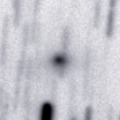
|
It brightened up to 2 mag by unusual major outburst in 2007. It will return in 2014. It will be 14 mag at best by normal prediction. But actually, it is already very bright as 13.5 mag (Nov. 25, Hidetaka Sato).
Date(TT) R.A. (2000) Decl. Delta r Elong. m1 Best Time(A, h)
Nov. 23 19 18.17 -27 55.4 2.828 2.270 46 14.7 18:19 ( 42, 13)
Nov. 30 19 32.49 -26 45.8 2.865 2.249 43 14.6 18:18 ( 45, 12)
|
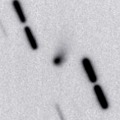
|
Now it is 15.5 mag (Oct. 18, F. Garcia). It is expected to brighten up to 7.5 mag and to be observable in excellent condition from summer to autumn in 2014 in the Southern Hemisphere. The condition is bad in the Northern Hemisphere. It will pass extremely close to Mars in 2014 October.
Date(TT) R.A. (2000) Decl. Delta r Elong. m1 Best Time(A, h)
Nov. 23 4 38.67 -37 26.3 3.755 4.351 121 15.0 0:32 ( 0, 18)
Nov. 30 4 26.46 -38 19.6 3.703 4.283 120 14.9 23:47 ( 0, 17)
|

|
Now it is 14.9 mag and visible visually (Nov. 8, Sandor Szabo). It keeps 14 mag for a long time until 2014 summer. It keeps observable in good condition in the Northern Hemisphere. It is observable only until February in the Southern Hemisphere.
Date(TT) R.A. (2000) Decl. Delta r Elong. m1 Best Time(A, h)
Nov. 23 4 31.63 -12 31.9 1.635 2.515 145 15.1 0:25 ( 0, 42)
Nov. 30 4 17.96 -10 46.5 1.563 2.454 147 14.9 23:38 ( 0, 44)
|
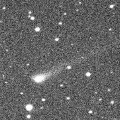
|
It keeps bright as 13-14 mag for a long time from 2013 to 2014. Now it is not observable. But it will appear in the morning sky again in 2014 February.
Date(TT) R.A. (2000) Decl. Delta r Elong. m1 Best Time(A, h)
Nov. 23 16 42.51 -24 14.4 4.077 3.117 11 14.9 18:19 ( 68,-11)
Nov. 30 16 54.37 -24 43.1 4.085 3.110 7 14.9 18:18 ( 69,-14)
|
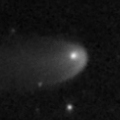
|
Now it is 15.7 mag (Oct. 11, Ken-ichi Kadota). It keeps 15 mag and observable in good condition in 2013. It locates somewhat low in the Northern Hemisphere.
Date(TT) R.A. (2000) Decl. Delta r Elong. m1 Best Time(A, h)
Nov. 23 3 31.79 -25 6.0 6.641 7.365 134 15.5 23:21 ( 0, 30)
Nov. 30 3 27.29 -24 40.1 6.704 7.397 131 15.5 22:49 ( 0, 30)
|
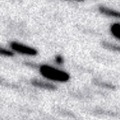
|
It reaches up to 12 mag in 2014 spring. But the condition in this apparition is bad. It locates low around the brightest days. Now it is 16.4 mag (Oct. 9, J. L. Martin). It keeps observable in good condition until winter when the comet will brighten up to 15-16 mag.
Date(TT) R.A. (2000) Decl. Delta r Elong. m1 Best Time(A, h)
Nov. 23 20 7.74 -13 20.3 2.737 2.414 60 15.7 18:19 ( 41, 31)
Nov. 30 20 18.58 -13 6.0 2.772 2.372 56 15.6 18:18 ( 45, 29)
|

|
Now it is 16.3 mag (Oct. 21, V. Benishek, B. Benishek). It tends to be brightest 4 months after the perihelion passage. It will reach up to 15.5 mag from autumn to winter, and will be observable in excellent condition.
Date(TT) R.A. (2000) Decl. Delta r Elong. m1 Best Time(A, h)
Nov. 23 6 40.64 17 1.1 1.269 2.126 140 15.6 2:34 ( 0, 72)
Nov. 30 6 37.13 17 23.5 1.252 2.155 148 15.6 2:03 ( 0, 72)
|
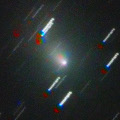
|
It brightened up to 9-10 mag in 2013 spring. Now it is fading. It has already faded down to 15.8 mag (Oct. 7, Hidetaka Sato). In the Southern Hemisphere, it keeps observable for a long time until the comet fades out, although it keeps locating low. It will never be observable again in the Northern Hemisphere.
Date(TT) R.A. (2000) Decl. Delta r Elong. m1 Best Time(A, h)
Nov. 23 14 16.81 -62 41.4 3.566 2.960 45 15.7 5:13 (331,-24)
Nov. 30 14 38.80 -63 25.0 3.639 3.029 45 15.8 5:19 (333,-23)
|
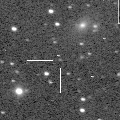
|
It is expected to brighten up to 13 mag and to be observable in excellent condition from spring to summer in 2014. Appearing in the morning sky. It has not been observed since May. But it must be already brightening up to 16.5 mag.
Date(TT) R.A. (2000) Decl. Delta r Elong. m1 Best Time(A, h)
Nov. 23 12 23.46 -4 36.5 3.428 2.949 53 15.9 5:13 (303, 32)
Nov. 30 12 33.21 -5 35.7 3.325 2.923 57 15.8 5:19 (309, 35)
|
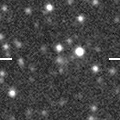
|
Now it is 16.8 mag (Nov. 2, J. F. Hernandez). It will brighten rapidly and will be observable at 15 mag in winter in excellent condition in the Northern Hemisphere. It locates low in the Southern Hemisphere.
Date(TT) R.A. (2000) Decl. Delta r Elong. m1 Best Time(A, h)
Nov. 23 4 34.23 41 41.8 1.076 2.022 156 16.3 0:28 (180, 83)
Nov. 30 4 28.19 41 55.6 1.038 1.992 159 16.1 23:50 (180, 83)
|

|
It approached to the sun down to 0.14 A.U. on Oct. 7. In the Northern Hemisphere, it keeps observable at 16 mag in good condition from late October to mid December. In the Southern Hemisphere, it locates very low from November to December.
Date(TT) R.A. (2000) Decl. Delta r Elong. m1 Best Time(A, h)
Nov. 23 20 32.78 10 10.7 0.840 1.118 74 16.3 18:19 ( 53, 54)
Nov. 30 21 11.11 11 11.6 0.960 1.221 77 16.6 18:18 ( 51, 57)
|

|
It brightened up to 12 mag in 2012. It is bright as 14.1 mag still now (Oct. 27, Hidetaka Sato). It will be fading and getting lower after this, and will be unobservable at 17 mag in December.
Date(TT) R.A. (2000) Decl. Delta r Elong. m1 Best Time(A, h)
Nov. 23 20 24.11 -31 52.1 3.635 3.269 60 16.3 18:19 ( 27, 17)
Nov. 30 20 33.70 -31 14.3 3.732 3.285 56 16.4 18:18 ( 31, 16)
|

|
Now it is 16.8 mag (Nov. 6, G. Borisov, O. Bryzgalov). It keeps 15 mag for a long time from 2014 summer to 2015 summer. It keeps observable in good condition in the Northern Hemisphere. It becomes observable only after 2015 in the Southern Hemisphere.
Date(TT) R.A. (2000) Decl. Delta r Elong. m1 Best Time(A, h)
Nov. 23 5 29.94 50 13.0 3.474 4.317 144 16.6 1:23 (180, 75)
Nov. 30 5 24.34 51 2.6 3.402 4.272 148 16.5 0:50 (180, 74)
|
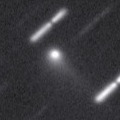
|
Brightened rapidly. Now it is visible visually at 14.3 mag (Oct. 11, Seiichi Yoshida). It keeps observable in excellent condition until autumn. Some visual observers reported it extremely bright as 12 mag in August.
Date(TT) R.A. (2000) Decl. Delta r Elong. m1 Best Time(A, h)
Nov. 23 22 5.52 6 34.7 2.011 2.316 94 16.5 18:19 ( 12, 61)
Nov. 30 22 15.76 7 6.6 2.110 2.341 90 16.6 18:18 ( 20, 61)
|
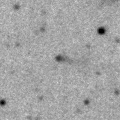
|
Now it is 17.2 mag (Oct. 9, C. Bell). It keeps 17 mag for a long time from 2013 summer to early 2015.
Date(TT) R.A. (2000) Decl. Delta r Elong. m1 Best Time(A, h)
Nov. 23 1 40.84 13 52.1 2.226 3.105 147 16.6 21:30 ( 0, 69)
Nov. 30 1 38.84 13 25.6 2.276 3.097 139 16.7 21:01 ( 0, 68)
|
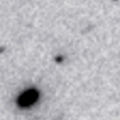
|
It is expected to brighten up to 13 mag and to be observable in good condition in 2015. Now appearing in the morning sky. In 2014, it will be observable at 15 mag in good condition from winter to summer.
Date(TT) R.A. (2000) Decl. Delta r Elong. m1 Best Time(A, h)
Nov. 23 13 16.30 -3 0.6 6.280 5.587 42 17.0 5:13 (292, 23)
Nov. 30 13 21.55 -3 22.8 6.156 5.542 47 16.9 5:19 (297, 28)
|

|
It brightened up to 14.0 mag from spring to summer (June 11, Sandor Szabo). Now it is fading. It will be observable at 17-18 mag from winter to spring. It locates somewhat low in the Southern Hemisphere.
Date(TT) R.A. (2000) Decl. Delta r Elong. m1 Best Time(A, h)
Nov. 23 13 42.10 0 30.9 4.494 3.770 38 16.9 5:13 (284, 20)
Nov. 30 13 44.92 1 16.0 4.432 3.800 45 16.9 5:19 (289, 27)
|
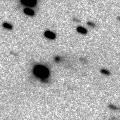
|
Now it is 17.6 mag (Oct. 11, A. Smolin). It will be observable at 17 mag in excellent condition from autumn to winter.
Date(TT) R.A. (2000) Decl. Delta r Elong. m1 Best Time(A, h)
Nov. 23 2 47.62 17 55.0 1.632 2.596 164 17.1 22:37 ( 0, 73)
Nov. 30 2 44.36 17 18.7 1.660 2.593 156 17.1 22:06 ( 0, 72)
|
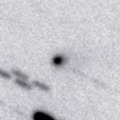
|
First return of a new periodic comet discovered in 1998. Now it is 17.6 mag (Oct. 4, K. Hills). It is fainter than originally expected by 2 mag. It was expected to be observable at 15.5 mag in good condition from 2013 autumn to early 2014. But actually, it will be 17 mag at best.
Date(TT) R.A. (2000) Decl. Delta r Elong. m1 Best Time(A, h)
Nov. 23 1 37.32 -22 43.1 1.893 2.595 125 17.2 21:27 ( 0, 32)
Nov. 30 1 35.67 -21 14.6 1.936 2.582 120 17.2 20:58 ( 0, 34)
|

|
The condition is worst and the comet will be hardly observable in this apparition. Now it is appearing in the morning sky in the Northern Hemisphere. Now it is 17.8 mag (Oct. 31, Jean-Francois Soulier).
Date(TT) R.A. (2000) Decl. Delta r Elong. m1 Best Time(A, h)
Nov. 23 13 21.11 1 4.7 2.556 1.955 43 17.3 5:13 (287, 25)
Nov. 30 13 33.17 0 6.9 2.555 2.014 46 17.6 5:19 (292, 28)
|
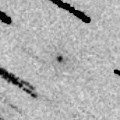
|
Although it had been fainter than expected, it is brightening now. Probably it tends to be brightest after the perihelion passage. Now it is 17.0 mag (Oct. 7, D. Buczynski). It keeps observable at 17-18 mag until December. It locates somewhat low in the Southern Hemisphere.
Date(TT) R.A. (2000) Decl. Delta r Elong. m1 Best Time(A, h)
Nov. 23 4 55.24 24 13.5 0.910 1.882 165 17.3 0:49 ( 0, 79)
Nov. 30 4 47.15 23 50.8 0.945 1.929 174 17.4 0:13 ( 0, 79)
|
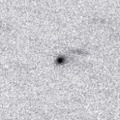
|
Now it is 17.4 mag (Sept. 25, Catalina Sky Survey). Brighter than origianlly predicted. It will be observable at 12-13 mag in excellent condition from 2014 summer to 2015 spring. In the Southern Hemisphere, it will locate low around the highlight.
Date(TT) R.A. (2000) Decl. Delta r Elong. m1 Best Time(A, h)
Nov. 23 0 12.65 -7 41.2 2.739 3.329 118 17.3 20:02 ( 0, 47)
Nov. 30 0 11.94 -7 17.8 2.795 3.292 111 17.3 19:34 ( 0, 48)
|

|
It was observed at 15-16 mag in 2012. Now it is fading slowly. But it keeps 15.6 mag still now (Oct. 13, Catalina Sky Survey). It will be fainter than 18 mag at the end of 2013. It locates low in the Southern Hemisphere.
Date(TT) R.A. (2000) Decl. Delta r Elong. m1 Best Time(A, h)
Nov. 23 0 18.45 17 5.6 4.212 4.894 129 17.3 20:08 ( 0, 72)
Nov. 30 0 15.06 15 35.6 4.352 4.935 121 17.4 19:37 ( 0, 71)
|
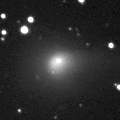
|
Fading slowly. It is bright as 15.1 mag still now (Nov. 1, Yasukazu Ikari). It keeps observable in good condition until the comet will be fainter than 18 mag in December.
Date(TT) R.A. (2000) Decl. Delta r Elong. m1 Best Time(A, h)
Nov. 23 0 36.09 -4 59.9 2.913 3.575 125 17.4 20:26 ( 0, 50)
Nov. 30 0 36.44 -5 4.3 3.072 3.644 118 17.6 19:59 ( 0, 50)
|

|
Now it is 18.6 mag (Oct. 13, Ken-ichi Kadota). It will brighten up to 14 mag around the perihelion passage in 2019. In 2013, it will be observable in good condition at 18 mag from summer to winter. It locates low in the Southern Hemisphere.
Date(TT) R.A. (2000) Decl. Delta r Elong. m1 Best Time(A, h)
Nov. 23 2 52.76 27 11.9 12.751 13.705 164 17.4 22:42 ( 0, 82)
Nov. 30 2 50.75 27 10.4 12.756 13.676 158 17.4 22:13 ( 0, 82)
|

|
Now it is 16.4 mag (Oct. 14, Catalina Sky Survey). It will be fading after this, and will be fainter than 18 mag in late December.
Date(TT) R.A. (2000) Decl. Delta r Elong. m1 Best Time(A, h)
Nov. 23 0 16.55 3 45.0 1.790 2.487 124 17.5 20:07 ( 0, 59)
Nov. 30 0 20.45 3 7.1 1.892 2.513 118 17.6 19:43 ( 0, 58)
|

|
It brightened up to 12-13 mag from autumn to winter in 2012. Now it is fading. It has already faded down to 16.8 mag (Nov. 8, P. C. Sherrod). It keeps observable for a long time until the end of 2013 when the comet becomes fainter than 18 mag.
Date(TT) R.A. (2000) Decl. Delta r Elong. m1 Best Time(A, h)
Nov. 23 6 5.28 0 39.6 3.726 4.548 142 17.6 1:58 ( 0, 56)
Nov. 30 6 1.87 -0 4.0 3.728 4.593 147 17.7 1:27 ( 0, 55)
|

|
Now it is 17.8 mag (Oct. 11, Ken-ichi Kadota). It keeps observable at 17.5 mag in good condition from autumn to winter.
Date(TT) R.A. (2000) Decl. Delta r Elong. m1 Best Time(A, h)
Nov. 23 7 30.61 18 3.3 1.426 2.187 129 17.7 3:23 ( 0, 73)
Nov. 30 7 29.81 18 40.2 1.392 2.213 136 17.7 2:55 ( 0, 74)
|

|
Now it is 17.1 mag (Oct. 12, Toshiyuki Takahashi). It was observed at 18 mag in 2012. It will be observable at 17 mag in excellent condition in 2013.
Date(TT) R.A. (2000) Decl. Delta r Elong. m1 Best Time(A, h)
Nov. 23 22 42.53 -13 27.0 4.298 4.516 96 17.7 18:33 ( 0, 42)
Nov. 30 22 41.18 -14 18.2 4.445 4.531 88 17.8 18:18 ( 4, 41)
|
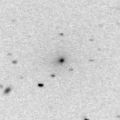
|
It brightened rapidly, and it keeps bright as 16.0 mag still now (Oct. 7, Hidetaka Sato). It will be fading after this. But it may keep 16 mag some more time. It will be getting higher gradually in the Southern Hemisphere. But it keeps locating extremely low in the Northern Hemisphere.
Date(TT) R.A. (2000) Decl. Delta r Elong. m1 Best Time(A, h)
Nov. 23 10 11.08 -46 29.6 2.604 2.493 72 17.8 5:13 (351, 8)
Nov. 30 9 55.35 -48 44.4 2.546 2.539 78 18.0 5:19 ( 0, 6)
|
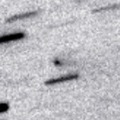
|
Now it is 18.7 mag (Sept. 27, Yasukazu Ikari). It was expected to brighten up to 16.5 mag from autumn to winter. But actually, it seems to be already fading.
Date(TT) R.A. (2000) Decl. Delta r Elong. m1 Best Time(A, h)
Nov. 23 3 1.37 6 37.7 1.195 2.153 161 17.9 22:51 ( 0, 62)
Nov. 30 2 58.53 5 38.6 1.220 2.149 153 18.0 22:20 ( 0, 61)
|

|
It keeps 18-19 mag for a long time until 2015. It is observable at 18 mag in good condition in this winter.
Date(TT) R.A. (2000) Decl. Delta r Elong. m1 Best Time(A, h)
Nov. 23 6 26.26 12 25.7 6.793 7.603 142 18.0 2:19 ( 0, 67)
Nov. 30 6 21.46 11 55.4 6.730 7.603 150 17.9 1:47 ( 0, 67)
|
|
![]()
 117P/Helin-Roman-Alu 1
117P/Helin-Roman-Alu 1 C/2009 F4 ( McNaught )
C/2009 F4 ( McNaught ) 4P/Faye
4P/Faye 84P/Giclas
84P/Giclas C/2012 L2 ( LINEAR )
C/2012 L2 ( LINEAR ) 134P/Kowal-Vavrova
134P/Kowal-Vavrova 52P/Harrington-Abell
52P/Harrington-Abell (3200) Phaethon
(3200) Phaethon 246P/2010 V2 ( NEAT )
246P/2010 V2 ( NEAT ) C/2013 V2 ( Borisov )
C/2013 V2 ( Borisov ) P/2013 J2 ( McNaught )
P/2013 J2 ( McNaught ) 119P/Parker-Hartley
119P/Parker-Hartley C/2012 F3 ( PanSTARRS )
C/2012 F3 ( PanSTARRS ) C/2012 K6 ( McNaught )
C/2012 K6 ( McNaught ) 291P/2013 N2 ( NEAT )
291P/2013 N2 ( NEAT ) 292P/2013 O1 ( Li )
292P/2013 O1 ( Li ) 46P/Wirtanen
46P/Wirtanen 184P/Lovas 2
184P/Lovas 2 32P/Comas Sola
32P/Comas Sola C/2012 A2 ( LINEAR )
C/2012 A2 ( LINEAR ) C/2013 E2 ( Iwamoto )
C/2013 E2 ( Iwamoto ) C/2010 U3 ( Boattini )
C/2010 U3 ( Boattini ) 257P/2012 F4 ( Catalina )
257P/2012 F4 ( Catalina ) C/2012 J1 ( Catalina )
C/2012 J1 ( Catalina ) 178P/Hug-Bell
178P/Hug-Bell C/2012 S4 ( PanSTARRS )
C/2012 S4 ( PanSTARRS ) C/2013 G6 ( Lemmon )
C/2013 G6 ( Lemmon ) P/2013 O2 ( PanSTARRS )
P/2013 O2 ( PanSTARRS ) C/2012 A1 ( PanSTARRS )
C/2012 A1 ( PanSTARRS )![]()











































